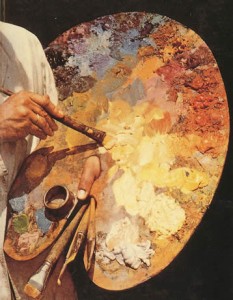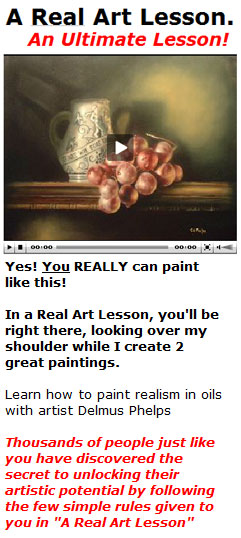Artist Paint Palette
Posted by admin | Under Color Sunday Apr 25, 2010 The number of different oil colors in any art shop can be staggering. It can also be baffling, because individual ranges may have similar colors under different proprietary names; and it can be off-putting, because the very fact of having so much so easily available may stop you from learning to understand the principles of color and of color mixing.
The number of different oil colors in any art shop can be staggering. It can also be baffling, because individual ranges may have similar colors under different proprietary names; and it can be off-putting, because the very fact of having so much so easily available may stop you from learning to understand the principles of color and of color mixing.
Working outdoors, however, can actually help you to appreciate fine pigments. Our color codes will show you just how much can be produced from only a few basic tubes. You’ll need to take with you the colors listed below.
Oil colors are pigments already mixed with a small amount of oil to help them flow. You can add more oil, or turpentine, to thin out the paint, or white to lighten the effect. Never use white spirit instead of turpentine; made of rectified paraffin, it usually contains impurities that affect some of the colors quite badly.
An important reason for mixing your own colors is that some commercially produced tones are extremely fugitive – that is, they will fade or discolor quickly. This is especially true if they are subjected to strong sunlight, as they would be out of doors.
Although there are some colors that will not be as clear in the cheaper grades, those listed below are all perfectly satisfactory in student quality. As your work improves, do add some artist’s colors to your palette; they are more finely ground, have few or no additives and are of incomparable intensity.
Basic palette
- White
- Cadmium yellow
- Yellow ochre
- Cadmium red
- Alizarin crimson
- Burnt umber
- Viridian green
- Ultramarine blue
- Ivory black
Acrylic paints often have different names from traditional oil paints, and the range is much more limited. However, you will be able to find the basic seven colors you need by looking at the chart in your local supply store. If you are using canvas or boards, you will need a special acrylic primer, and there are gloss, and matt mediums instead of linseed oils or turpentines. Acrylics dry more quickly than oils, are more flexible and don’t harden with age or change color, but the texture is different. Working with one or the other becomes a personal choice.
Once you have mastered the basic colors, you can add already mixed paints in a few shades to save time. The colors I would choose for any long painting trip would be those based on the earth and sky shades that I use most often in outdoor painting.
Remember that the color will vary slightly according to how you put it onto the canvas. Like most artists I learned to work in a way that is generally known as ‘lean to fat’,
In this the first washes are applied with only enough turpentine to smooth the paint Into the fabric. The effect is generally quite opaque, the colors changing from the deep blobs on the palette to a much dryer, almost filmy look.
These lean washes provide the best background for any style of painting.
Gradually, as I work nearer the foreground, and therefore nearer surface of the finished painting, I mix turpentine and! Or oil with the pigment, achieving more and richer coloring, and greater depth of intensity and tone. I add the top highlights with pure pigment and oil to give a final sheen, providing sparkle and light wherever it is most appropriate.
You will find that one of the great advantages of painting in oil is that you can physically move the paint about. If you go off to lunch, leaving the painting to dry, you may well come back and decide that a section on the right or left is not what you really want; with a few flicks of the palette knife you can be back to the canvas. No other medium can be treated this way. It makes it easy to begin when you know that changing your mind is always a possibility.
Extended palette
- White
- Lemon yellow
- Cadmium yellow
- Yellow ochre
- Cadmium red
- Alizarin crimson
- Purple
- Indian red
- Viridian green
- Light green
- Raw sienna
- Burnt sienna
- Raw umber
- Cerulean blue
- Cobalt blue
- Prussian blue
- Ultramarine blue
- Ivory Jack
- Lamp black
